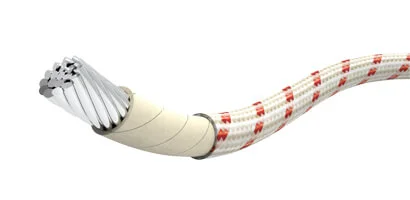Ultra-High Temperature Wire & Cables, which operate at 450°C, provide remarkable thermal resistance, making them excellent for demanding industrial applications. They provide consistent performance in extreme heat settings by using strong insulating materials, ensuring safety and efficiency.

Operating Temperature: -60°C to +450°C
Operating Voltage: 600V
Insulation: composites
Approval: UL/cUL

Operating Temperature: -60°C to +450°C
Operating Voltage: 300V
Insulation: composites
Approval: UL/cUL

Operating Temperature: -60°C to +450°C
Operating Voltage: 600V
Insulation: composites
Approval: UL/cU
1. Material Selection:
Insulation Materials:
Choose high-temperature insulation materials capable of withstanding temperatures up to 450°C, such as advanced ceramics (e.g., alumina), mineral-based fibers (e.g., fiberglass), refractory metals, and specialty polymers like fluoropolymers (e.g., PTFE) or silicone rubber.
Conductor Materials:
Select conductive materials with high melting points and excellent heat resistance, including nickel-based alloys (e.g., Inconel), refractory metals (e.g., tungsten, molybdenum), or high-temperature copper alloys.
2. Extrusion and Coating:
Insulation Extrusion:
Use specialized extrusion processes to apply high-temperature insulation materials onto conductive wires.
Control extrusion parameters such as temperature, pressure, and die design to ensure uniform insulation thickness and adhesion to the conductor.
Coating and Encapsulation:
Apply additional protective coatings or encapsulants to enhance mechanical strength, chemical resistance, and environmental durability.
Utilize techniques like dip coating, spray coating, or powder coating depending on the specific application requirements.
3. Wire Drawing and Forming:
Conductor Drawing:
Process raw conductor materials through wire drawing machines to reduce diameter and achieve desired mechanical properties.
Control drawing parameters (e.g., temperature, speed, die geometry) to optimize conductor strength and conductivity.
Stranding and Braiding:
Strand multiple drawn wires together to create flexible cable configurations suitable for high-temperature applications.
Implement braiding or shielding techniques using high-temperature alloys or metal fibers to enhance mechanical durability and electromagnetic interference (EMI) shielding.
4. Curing and Heat Treatment:
Insulation Curing:
Subject insulated wires and cables to controlled curing processes to promote material cross-linking and enhance thermal stability.
Utilize heat treatment ovens or autoclaves to achieve specific material properties and eliminate residual stresses.
5. Quality Control and Testing:
Dimensional Inspection:
Conduct precision measurements to verify wire diameter, insulation thickness, and overall cable geometry.
Electrical Testing:
Perform electrical tests such as insulation resistance, dielectric strength, and continuity checks to ensure compliance with performance specifications.
Mechanical Testing:
Evaluate mechanical properties including tensile strength, flexibility, and abrasion resistance through standardized testing methods.
Environmental Testing:
Subject wires and cables to thermal cycling, humidity exposure, chemical resistance tests, and other environmental simulations to assess long-term durability.
6. Packaging and Labeling:
Final Assembly:
Complete final assembly of wires and cables by cutting to specified lengths, terminating with connectors, and applying protective sheathing or labels.
Packaging and Shipping:
Package finished products in suitable containers or spools to protect against handling damage and facilitate transportation to end-users or distributors.
1. Aerospace and Aviation:
Engine Wiring: Wires used in jet engines and rocket propulsion systems where temperatures can exceed 450°C.
Avionics Systems: Cables connecting electronic components in aircraft and spacecraft operating in high-temperature environments.
2. Automotive Industry:
Engine Compartments: Wiring harnesses and sensors in vehicles exposed to high temperatures near engine components.
Exhaust Systems: Cables used in exhaust gas sensors and emission control systems.
3. Industrial Processing:
Metallurgy: Wiring for furnaces, smelters, and metal processing equipment where temperatures reach or exceed 450°C.
Glass Manufacturing: Cables for glass furnaces and molten glass handling equipment.
4. Research and Laboratory Equipment:
High-Temperature Chambers: Wires and cables used in thermal testing chambers and environmental simulation equipment.
Scientific Instruments: Wiring for instruments used in materials science, chemistry, and physics research requiring ultra-high temperature resistance.
5. Power Generation:
Turbines and Generators: Cables used in gas turbines, steam turbines, and power generation equipment operating at elevated temperatures.
Nuclear Power Plants: Wiring for reactor systems and components exposed to high heat.
6. Oil and Gas Industry:
Downhole Applications: Wires used in drilling equipment, well logging tools, and oilfield instrumentation exposed to extreme heat downhole.
Refinery Operations: Cables for processing units and equipment in refineries handling high-temperature fluids and gases.
7. High-Temperature Sensors and Controls:
Thermocouple Cables: Wiring for temperature measurement and control systems in industrial processes and equipment.
Heating Elements: Cables used in high-temperature heating applications for industrial and commercial ovens, kilns, and heaters.
8. Specialized Equipment and Machinery:
Semiconductor Manufacturing: Wiring for semiconductor processing equipment operating in high-temperature cleanroom environments.
Foundry Equipment: Cables used in metal casting and molding machines where temperatures are extremely high.